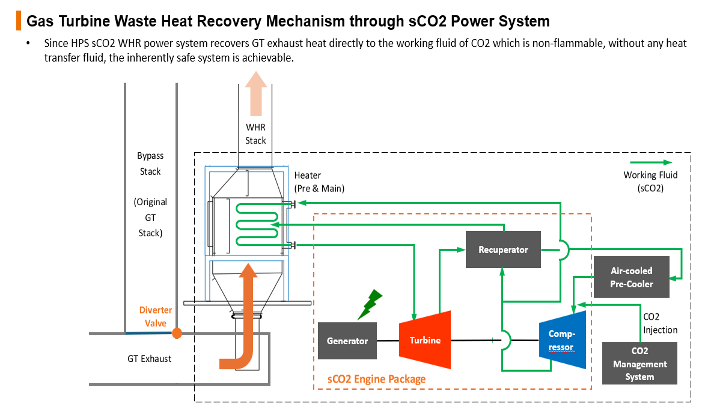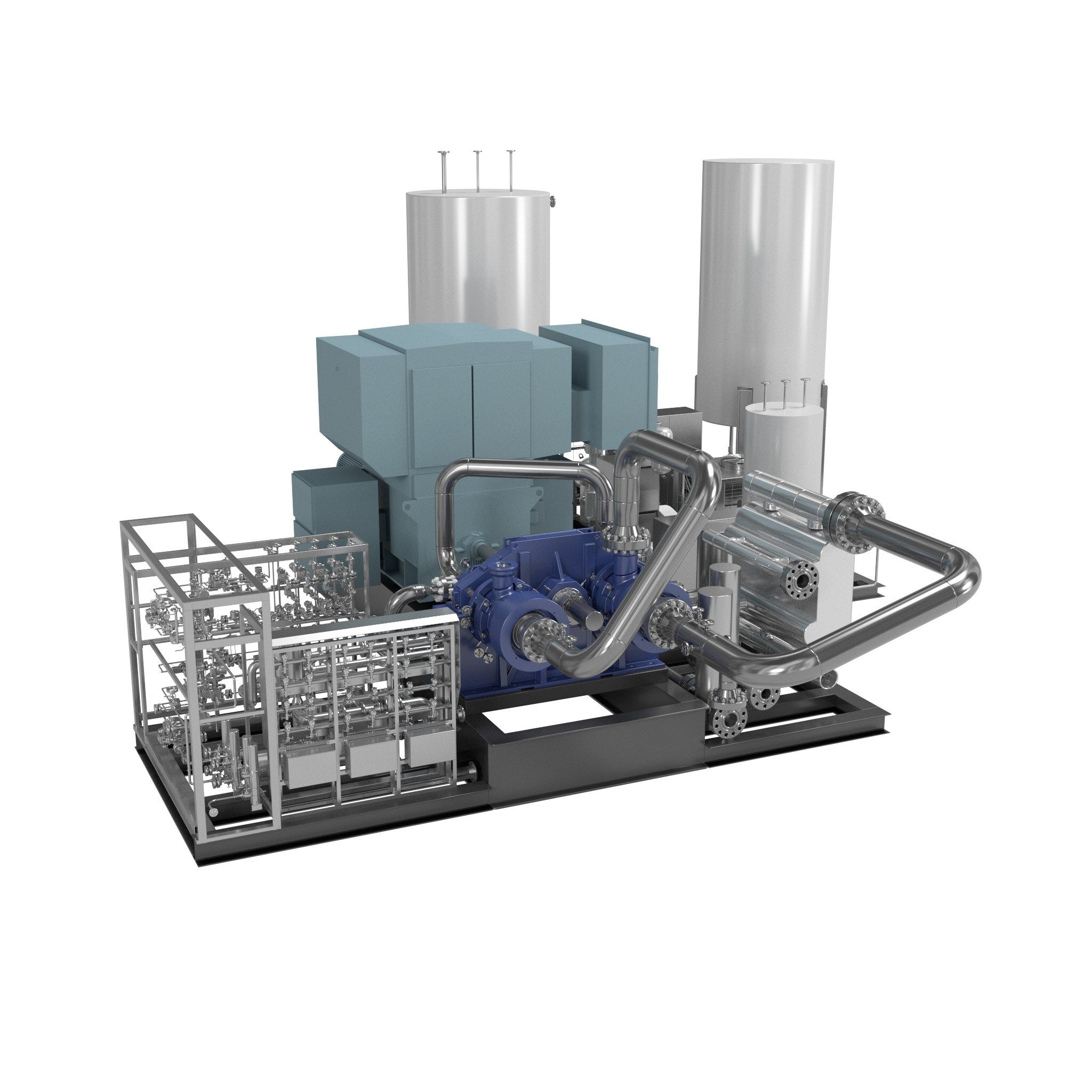Simplicity, Efficiency, and Low-Carbon Intensity: Hanwha Power Systems’ sCO2 System
Hanwha Power Systems offers insights into its supercritical CO2 systems that leverage high energy and dual gas/liquid properties to efficiently drive larger machines.
Hanwha Power Systems is developing a supercritical CO2 (sCO2) waste heat recovery project at TC Energy’s natural gas pipeline compressor station in West Virginia. The project’s sCO2 power generation system is designed to recover and utilize waste-heat exhaust from a gas turbine compressor, offering a lower-cost and carbon-free solution for renewable electricity.
Turbomachinery International interviewed a spokesperson from Hanwha Power Systems’ sCO2 team, who cited the numerous advantages of using sCO2 for power generation, reinforcing the common operating themes of simplicity, efficiency, and lower carbon footprint. With these benefits in mind, supercritical systems are expected to grow beyond typical gas turbine and compressor applications, permeating industries like solar and nuclear.
TURBO: What are the goals of the waste-heat recovery project?
Hanwha Power Systems: The ultimate goal of waste-heat recovery is to contribute to achieving net zero by reducing carbon intensity. Waste-heat recovery systems can lower the carbon intensity of the overall energy system by producing carbon-free electricity without additional fuel consumption. This is particularly beneficial for power generation solutions that use fossil fuels as their primary fuel and produce high-temperature waste heat, as it allows them to generate the same amount of electricity with less fuel or produce more electricity with the same amount of fuel. While waste-heat recovery may not entirely eliminate carbon emissions at the source, it is one of the most effective methods to reduce carbon emissions per unit of electricity and is an essential component for achieving net zero.
TURBO: How do sCO2 systems use waste-heat exhaust from gas turbine compressors to generate power?
Hanwha Power Systems: When exhaust gases from a gas turbine are directed to a heat exchanger connected to an sCO2 system, the high-pressure working fluid inside the heat exchanger absorbs the heat and reaches a high-temperate state. This sCO2, now in high-temperature and high-pressure states with significant energy, is then used to drive a turbine to generate electricity.

TURBO: Why is the 100% water-free feature advantageous in a closed-loop sCO2 system?
Hanwha Power Systems: The greatest advantages are flexibility of application and system simplification. The most common waste-heat recovery solution is the steam turbine, which uses water as its working fluid. However, this can pose challenges in remote areas (compressor stations in gas pipelines) or deserts where water is scarce. Even when large-scale water supply is available, additional water treatment facilities are required. Therefore, the water-free feature of the sCO2 system offers significant advantages, enabling their applications across various sites regardless of water availability. Additionally, the absence of water treatment simplifies the system and reduces capital expenses.
TURBO: What does the installation and integration process entail at a natural gas pipeline compressor station? What is the timeframe?
Hanwha Power Systems: The entire process is as follows:
Site Evaluation (1 - 2 months) — Design and Manufacturing/Site Construction (~18 months) — Installation and Commissioning (3 - 4 months) — Commercial Operation
After a site evaluation, including economic evaluation (performance) and installation feasibility, the design and manufacturing process begins, considering the specifications and safety regulations of the pipeline compressor stations. During the manufacturing phase, foundation and electrical work are conducted onsite. Once the sCO2 system is installed and commissioning is carried out at the site, the entire process takes approximately 22 - 24 months.
sCO2 waste heat recovery system; image credit: PR Newswire

TURBO: Are other locations planned for installation?
Hanwha Power Systems: A project is currently underway at an oil field in California. The business model involves installing an sCO2 system on a 20-MW gas turbine used for power generation at the oil field and selling the generated electricity to the grid. The project aims to commence commercial operation by the end of 2026.
TURBO: What are the advantages and disadvantages of using sCO2? Are there any safety concerns to be addressed?
Hanwha Power Systems:
Advantages: sCO2 possesses the dual advantage of a high-density liquid and low-friction gas, enabling turbomachinery to achieve high efficiency. Additionally, CO2 can reach supercritical conditions at lower pressures and temperatures compared to other common working fluids such as steam, allowing for a simplified system configuration.
Disadvantages: To use sCO2 as a working fluid, a dedicated system for storage, supply, and recovery is necessary, requiring 99.5% purity (industry grade) CO2. However, CO2 is easy to source, inexpensive, and manageable, posing no significant challenges in supply. Additionally, since CO2 operates in a closed-loop system, it is not continuously consumed.
Safety Concerns: If a leak occurs in an enclosed space, it can lead to asphyxiation. Therefore, gas detectors and ventilation systems are necessary in enclosed spaces. However, since the sCO2 system is fundamentally installed outdoors, no significant safety issues are expected from this setup.
TURBO: Are there any operational or maintenance considerations when using a system running on sCO2? If so, what are they?
Hanwha Power Systems: There are no inherent issues caused by sCO2 itself. Of course, materials and safety devices designed for high-temperature and high-pressure environments are utilized to ensure safe operation. At a temperature exceeding 400° C, CO2 can exhibit corrosive properties, but this can be effectively managed by optimizing low-alloy steel materials and thickness.
TURBO: How else is Hanwha Power Systems leveraging its sCO2 technology?
Hanwha Power Systems: In addition to gas turbines for compressor stations, we are working on applying sCO2 technology to utilize waste heat from ammonia-fueled gas turbines being developed for marine propulsion. Furthermore, as sCO2 demonstrates a greater efficiency advantage over traditional steam turbines with increasing heat-source temperatures, we are pursuing its application in emerging markets such as small modular reactors (SMR) and concentrated solar power (CSP). Among these, CSP is already in the production phase through the acquisition of a commercial project and is scheduled for delivery in 2025.
TURBO: What current and future trends does Hanwha Power Systems see in the sCO2 power generation market?
Hanwha Power Systems: Currently, various companies are developing sCO2 power generation systems, but commercialized cases are rare. In the short term, small- to medium-sized (5 - 20 MW) products for gas turbine waste-heat recovery are expected to be the main focus, likely expanding to sites where steam turbines are challenging to apply, such as locations with limited water resources. In the long term, as the SMR and CSP markets mature, the medium- to large-scale (30 - 100 MW) sCO2 market is anticipated to expand accordingly.